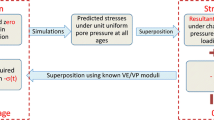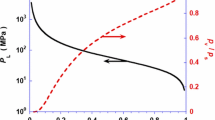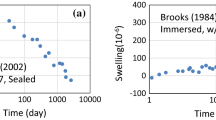Abstract
New investigations into very early volume change of aqueous cement dispersions allow us to understand better what is meant by the general term ‘chemical shrinkage’. In fact, early chemical shrinkage should be subdivided into dissolution shrinkage and hydration shrinkage, the latter taking place before as well as after the induction period. Shrinkage is evaluated by picnometry and by linear measurement carried out in three directions by means of an experimental set-up specially built to measure endogenous shrinkage right from the time after mixing. As expected, the volume of dissolved cement is a function of w/c-ratio, whereas the volume of early hydrated cement is independent of w/c-ratio. This relation, is linear and the slope as well as the intersection of the straight line with the ordinate vary depending on the cement composition. Therefore, these values may be considered to be indicating characteristic cement properties. In this way it becomes possible to classify cements and to predict the extent of early chemical shrinkage of mortar and concrete by just knowing their w/c-ratio.
Résumé
L'étude des réactions précoces qui ont lieu entre le ciment et l'eau permet de mieux comprendre la notion de «retrait chimique». En réalité, le retrait chimique devrait être sousdivisé en retrait de dissolution et en retrait d'hydratation, ce dernier apparaissant aussi bien avant qu'après la période d'induction. Le retrait a été évalué d'une part par picnométrie et d'autre part par des mesures linéaires, effectuées, dans trois directions à l'aide d'un dispositif instrumentalisé, spécialement conçu pour la mesure du retrait endogène dès le gâchage. Conformément aux prévisions, le volume de ciment dissous, est une fonction du rapport e/c, alors que le volume de ciment hydraté à ce stade précoce est constant et indépendant du rapport e/c. Il s'agit d'une fonction linéaire dont la pente et l'intersection avec l'ordonnée varient selon la composition des ciments. Par conséquent, les coefficients de cette droite pourraient caractériser un ciment. Ceci permettrait de classer les ciments et de prévoir, l'importance du retrait chimique précoce des mortiers et bétons en ne connaissant que leur rapport e/c.
Similar content being viewed by others
References
Doerr, H., ‘Hydration of tricalcium silicate at an early stage’, Doctoral thesis at the Technical University of Clausthal, Germany, 1979 (in German).
Bjøntegaard, Ø., ‘Thermal dilation and autogenous deformation as driving forces to self-induced stresses in high performance concrete’, Doctoral thesis at the Norvegian University of Science and Technology, Trondheim, Norway, 1999.
Uchikawa, H., Uchida, S., Ogawa, K. and Hanehara, S., ‘Influence of CaSO4·2H2O, CaSO4·1/2 H2O and CaSO4 on the initial hydration of clinker having different burning degree’,Cement and Concrete Research,14 (1984) 645.
Li, Z., Tanigawa, Y., Mori, H. and Kurokawa, Y., ‘Microscopic study on visco-elastic limit of cementious materials’,Trans. of the Japan Concrete Inst. 21 (1999) 29.
CRC Handbook of Chemistry and Physics. 69th Edition, 1988–1989.
Hanehara, S. and Yamada, K., ‘Interaction between cement and chemical admixture from the point of cement hydration, absorption behaviour of admixture, and paste rheology’,Cement and Concrete Research 29 (1999) 1159.
Shimasaki, I., Rokugo, K. and Morimoto, H., ‘On thermal expansion coefficient of concrete at very early ages’, Proceedings of International, Workshop on Control of Cracking in Early-Age Concrete, Tohoku University, Sendai, Japan (1999).
Damidot, D. and Nonat, A., ‘Investigations of the C3S hydration process during the first hours of hydration’, RILEM Proceedings 16 on Hydration and Setting of Cements, Dijon, France (1991).
Author information
Authors and Affiliations
Rights and permissions
About this article
Cite this article
Beltzung, F., Wittmann, F.H. Early chemical shrinkage due to dissolution and hydration of cement. Mat. Struct. 34, 279–283 (2001). https://doi.org/10.1007/BF02482207
Issue Date:
DOI: https://doi.org/10.1007/BF02482207




